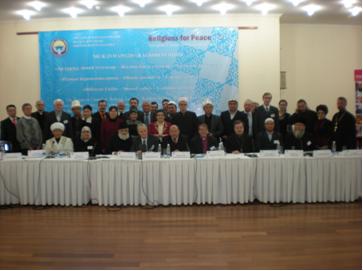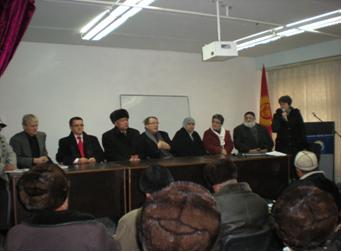As you know, I represent the Holy Family in the European Council of Religious Leaders. Recently I have had the opportunity to participate in a meeting of the Council in Kirgizstan and I would like to share with you some of my experience there.
LIVING COMMUNION: IN DIFFERENT ENVIRONMENTS WITH DIFFERENT
RELIGIOUS GROUPS |
As you know, I represent the Holy Family in the European Council of Religious Leaders. Recently I have had the opportunity to participate in a meeting of the Council in Kirgizstan and I would like to share with you some of my experience there.

Kirgizstan is a country situated in Central Asia, bordered by Kazakhstan, China, Tajikistan and Uzbekistan. It got its independence in 1991 after the breakup of the Soviet Union.
2010 has been a very important year for the people of Kirgizstan. There was a coup d’état, violent and often bloody disturbances, the uprising in the city of Osh in April and June, a referendum which led to parliamentary democracy and then elections which resulted in subsequent negotiations for the establishment of a coalition government.
In the midst of all this, the people of Kirgizstan have remained among the poorest in the region in economic terms. The transition from a communist regime to a democratic one has brought about changes: economic growth, (or the lack of it depending on your situation), drug trafficking, the proliferation of small arms, increase in fear among the population due to violence perpetrated by extreme religious groups and tense relations between the different ethnic groups.
You may ask: what is the objective of this Council of religious leaders and what role does it play in this reality?
The main objective of the visit of the delegation from the Council of religious leaders is to express solidarity with the religious leaders and the communities of Kirgizstan as they attempt to face the present challenges; to encourage them to take joint action and to promote reconciliation and the building up of the nation.
The dramatic events in Osh were not principally caused by religious conflicts although ethnicity did play a part. What some observers noted was that religious and community leaders had not played as constructive a role in the events as they could have.
That is why, during this visit, we met with different political, religious and civil organisations in the country to get to know the reality and make a more intensive study of the causes and possible joint solutions.
Religious leaders were consulted (64% Muslim, 12% Orthodox Christians 10% Catholics, Protestants and other religious denominations), in the hope that the people will come together to work constructively and cooperatively in the rebuilding of the nation and promoting peace and reconciliation.
On the third day of the visit, the central event was a conference organised by the European Council of Religious Leaders in conjunction with the State Commission of Religious Affairs in Kirgizstan. The theme of the conference was: “Different Beliefs, Common Values, and Joint Action”. There were more than 70 participants representing religious leaders, Government Officials, academic and civil institutions and a delegation of religious leaders from Europe. In the conference it was concluded that “the European Council of Religious Leaders should continue to consult with the religious leaders of Kirgizstan in order to explore how religious communities and their leaders can work together to promote reconciliation and peace in their country.”
You can read the complete text of the declaration by following the link below:
http://www.rfp-europe.eu/index.cfm?id=329587
Sr Marian Murcia



